JavaSE-1基础
reference:
https://www.bilibili.com/video/BV1Cv411372m/?vd_source=2654875159ed89b917fffce42a65196d
1. 入门概念
1.1 java有哪些技术平台?
JavaSE(标准版)、JavaEE(企业版)、JavaME(小型版)
1.2 如何使用java?
java语言的产品是jdk(java development kit,java开发工具包),必须安装jdk才能使用java语言
jdk8(常用)、jdk11、jdk17(新)是比较常用的LTS(long-term support,长期支持版)
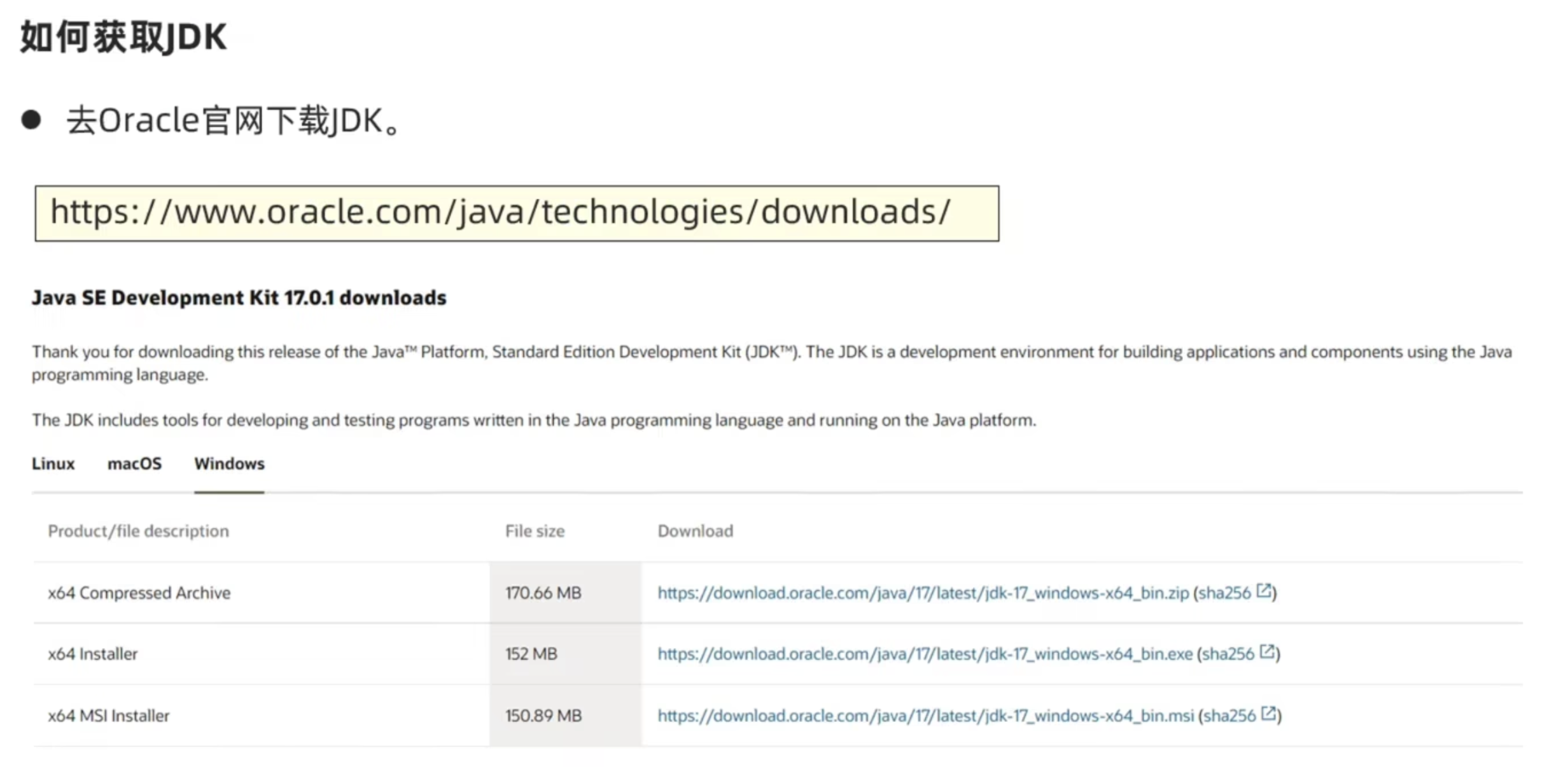
这里备注一个之前有的疑惑,就是说java前期更新比较慢,所以JDK1.8就是常说的java8了,然后好像从java9开始就不沿用1.x的这种命名方法了
1.3 java(运行)和javac(编译)的区别
javac时编译工具,java.exe是执行程序
1.4 java的一个过程

1
2
| javac HelloWorld.java
java HelloWorld
|
jdk11开始,可以直接java xxx.java这样的,还是上面那个过程,但是看起来是简化了
1.5 jdk的组成
- jvm(java virtual machine):java虚拟机,真正运行java程序的地方
- 核心类库:java自己写好的程序,留给程序员自己的程序调用的
- jre(java runtime environment):java的运行环境(jvm+核心类库)
- jdk(java development kit):java开发工具包(包括上面所有)
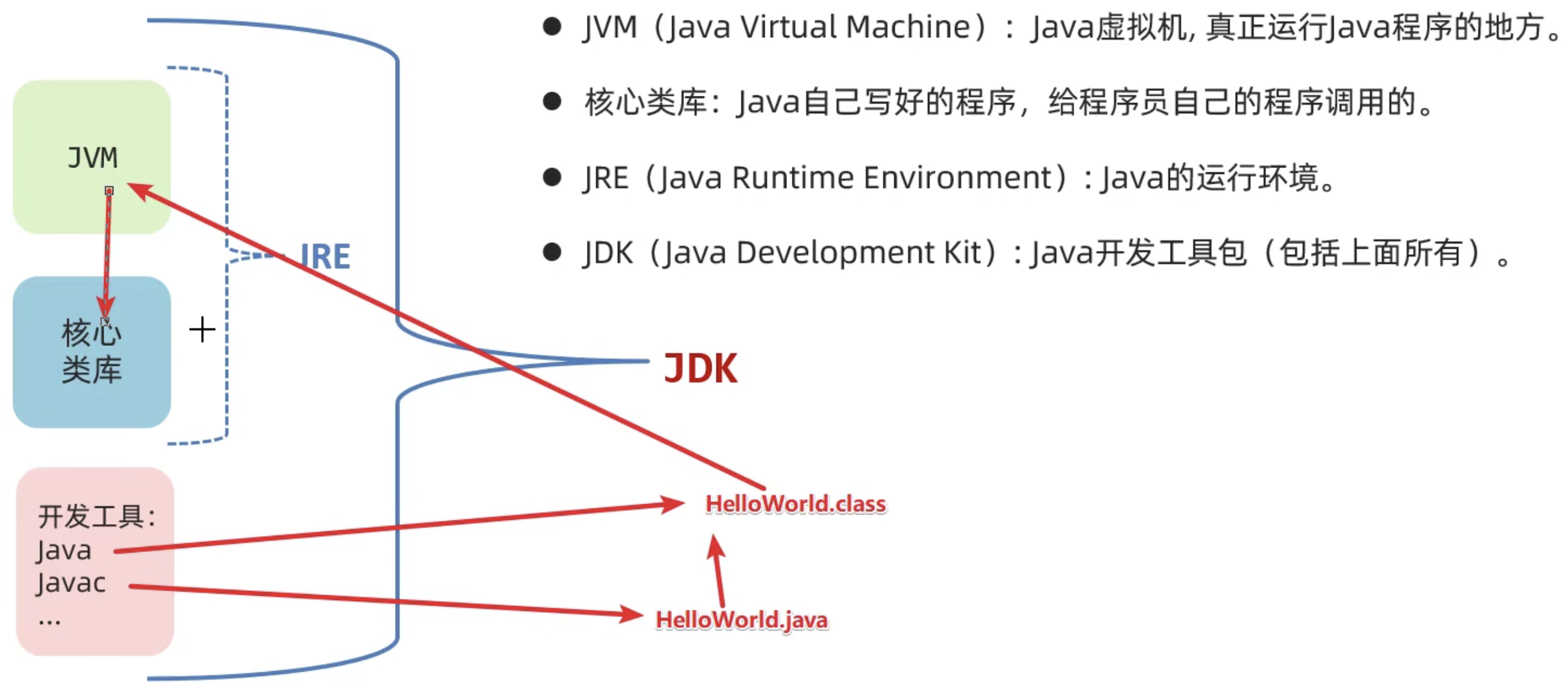
1.6 java的跨平台工作原理
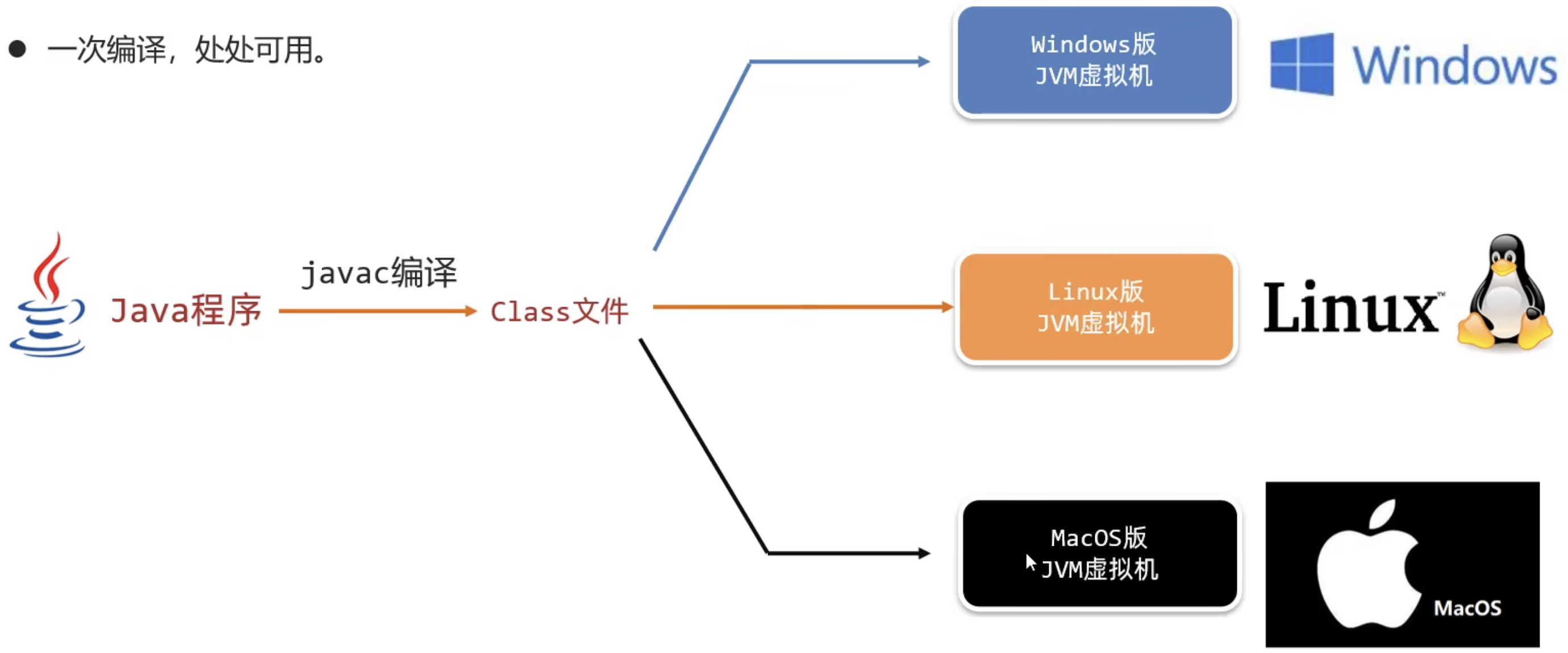
1.7 IDEA项目结构介绍
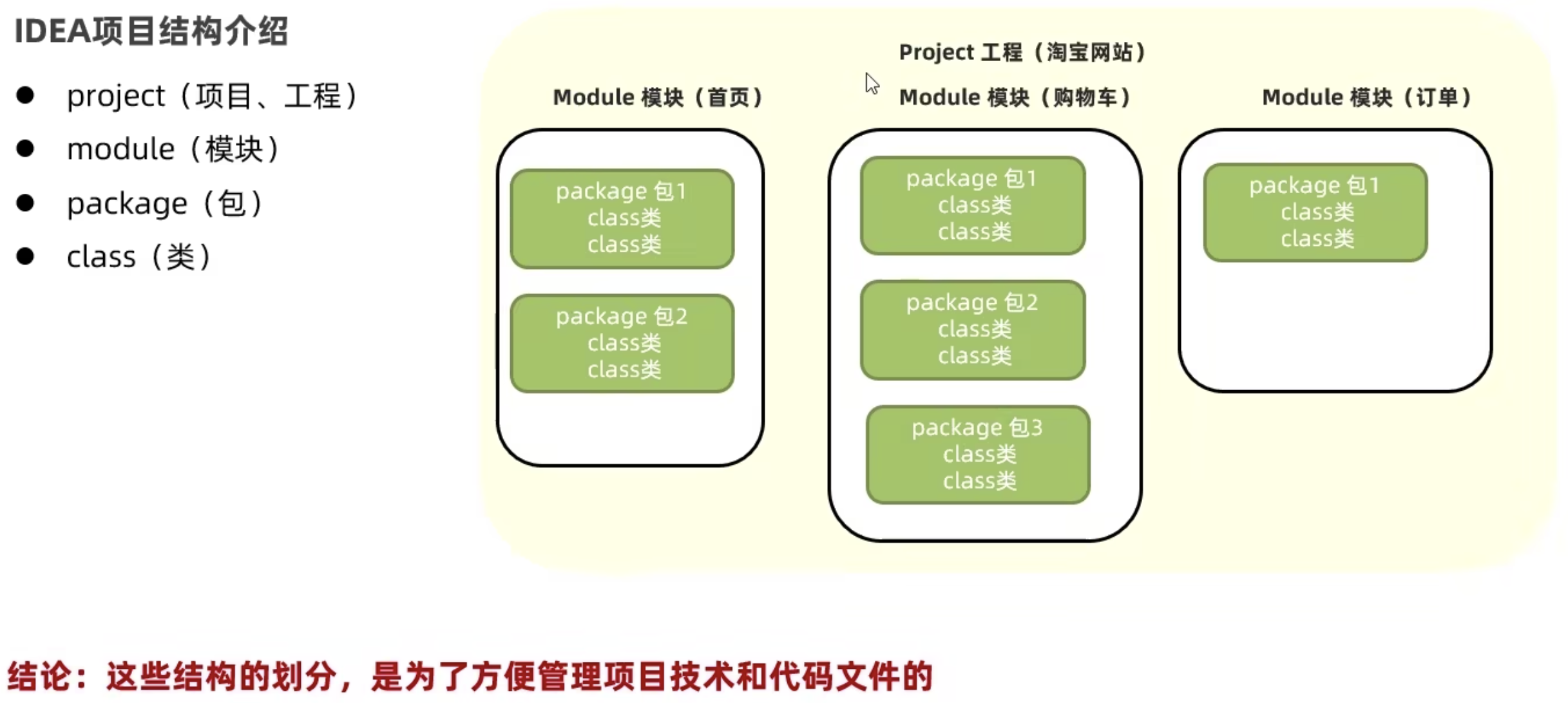
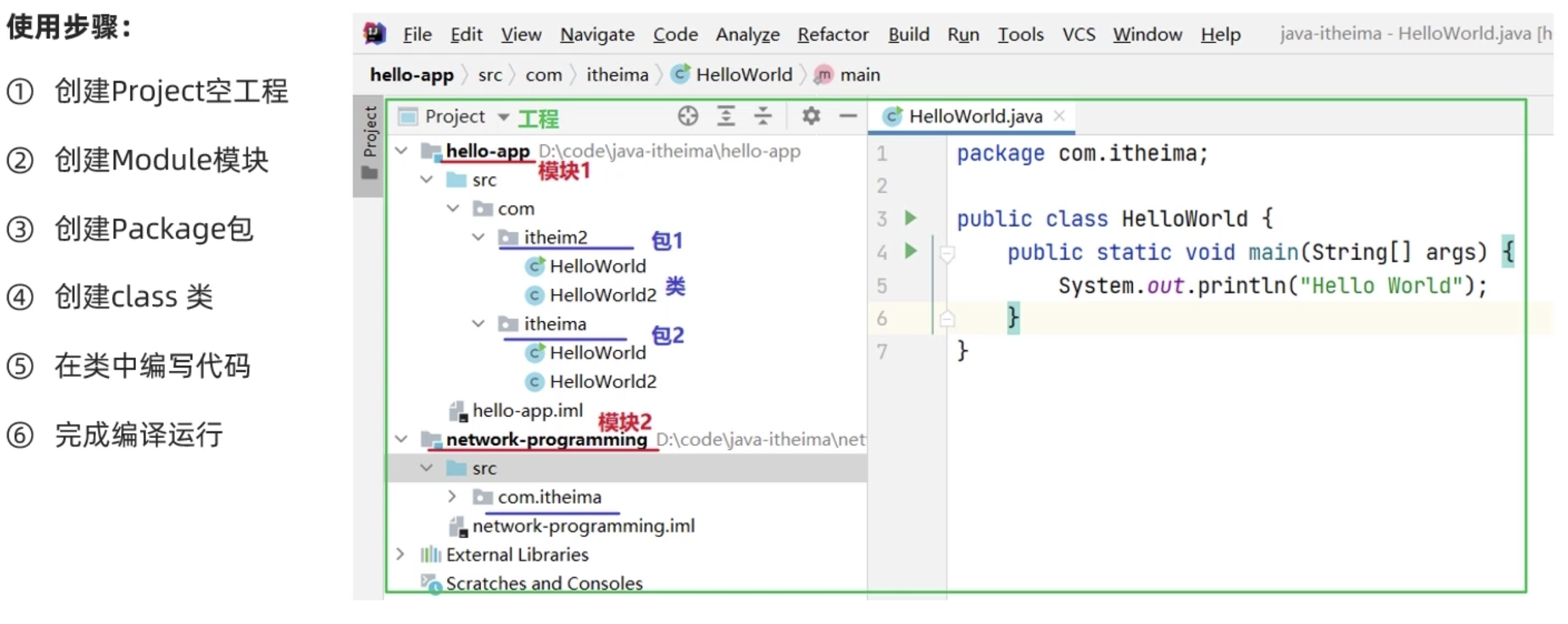
在目前练习,或者说初期使用的时候,直接建立empty的就可以,不过建基于maven的那些也是可以的
1.8 简单总结
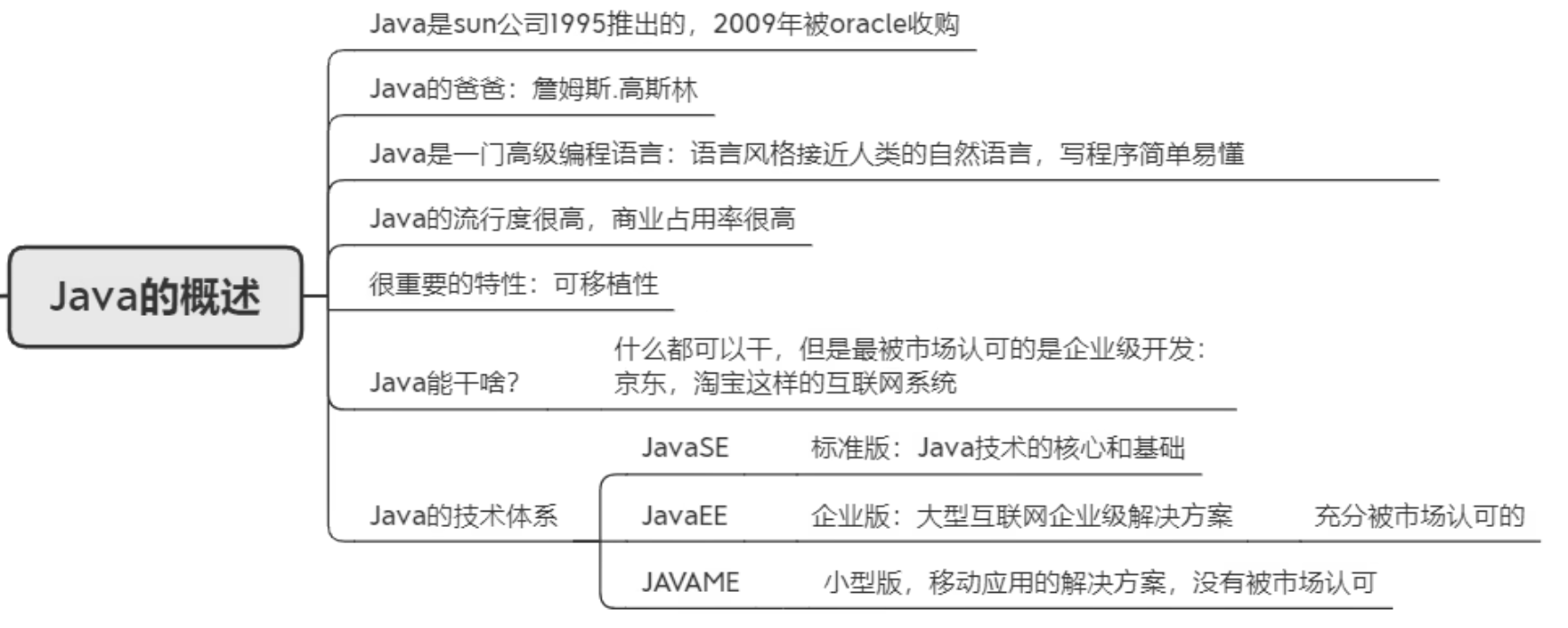
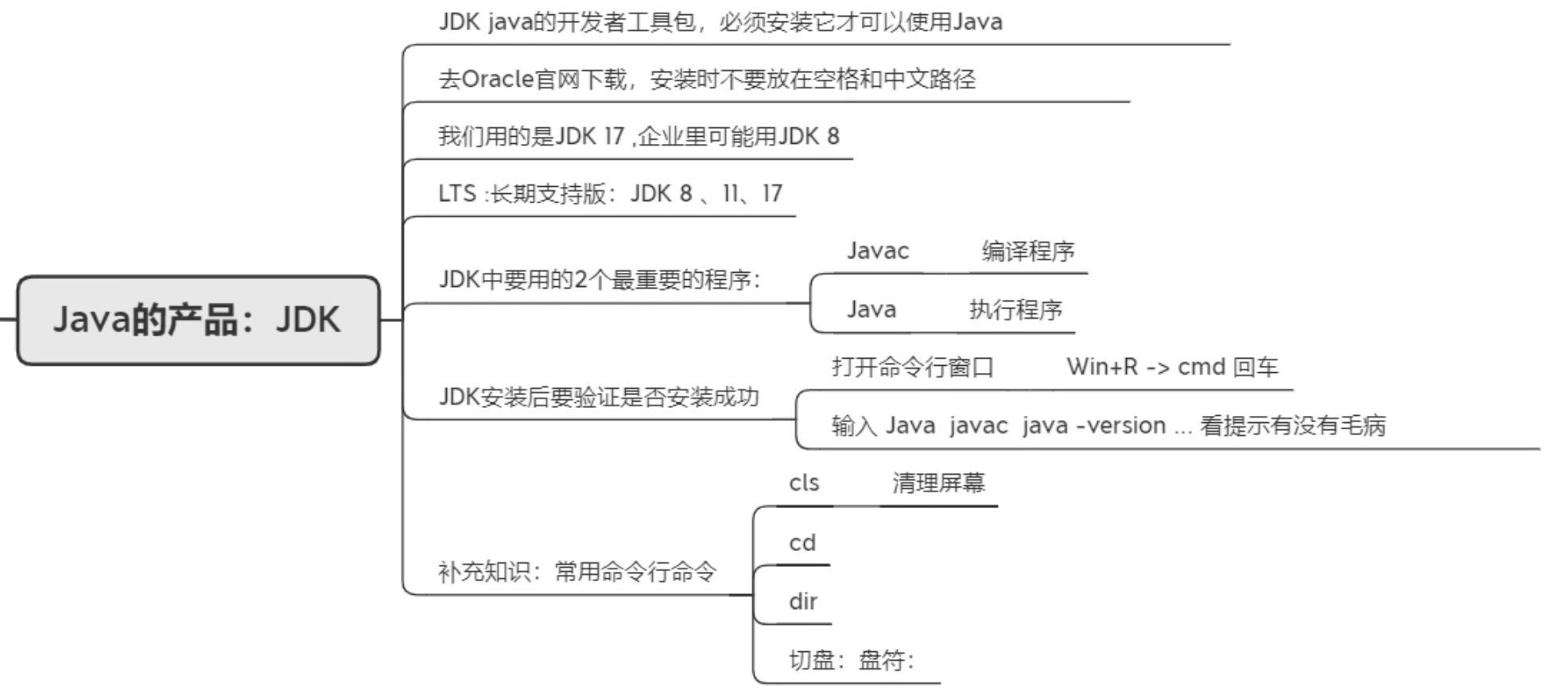



2. JavaSE基础语法(注释、变量、数据类型)
快捷键:option+command+l格式化代码
截止到这里:java快速入门和IDEA开发工具的使用给学完了,开始学习java基础语法
2.1 注释


2.2 字面量
字面量:数据在程序中的书写格式

注意单双引号的使用,还有一些特殊字符的使用
2.3 变量variable
2.3.1 变量定义的格式

数据类型 变量名称 = 初始值;
2.3.2 变量使用注意事项
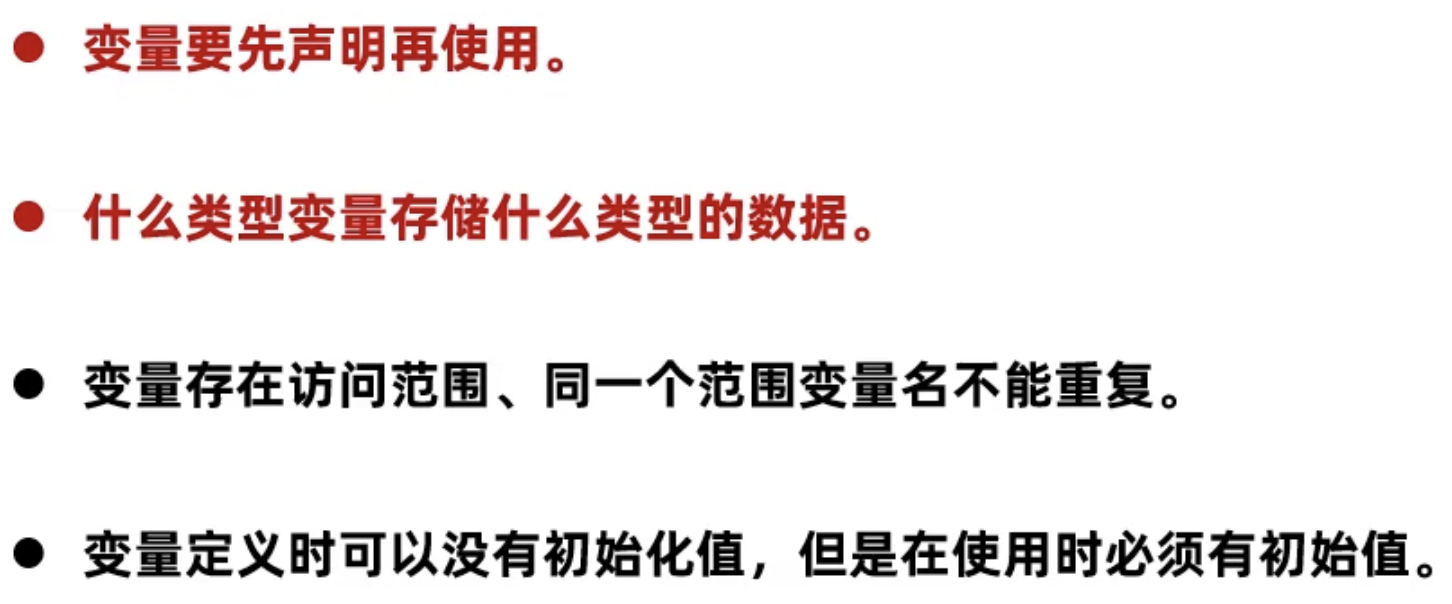
2.3.3 变量原理
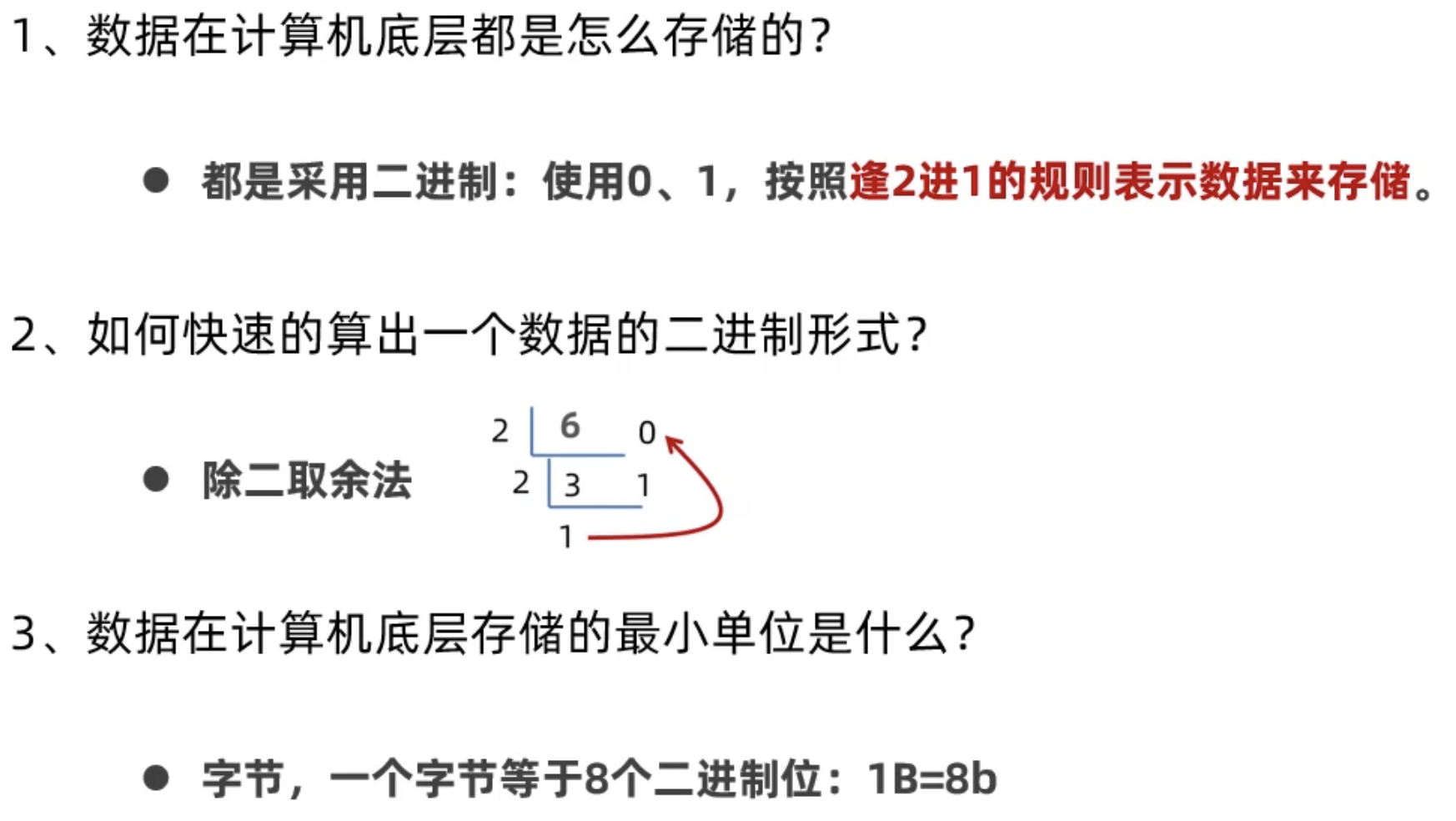
2.3.4 进制转换
1
2
3
| int i1 = 0B01100001;
int i2 = 0141;
int i3 = 0x61;
|
2.4 数据类型
2.4.1 基本数据类型:四大类八种

byte、short、int、long
float、double
char
boolean
注意,随便写一个证书字面量默认是int类型的,写一个比如132223243244233虽然没有超过long的范围,超过了范围则会报错
所以如果是希望随便写一个整数字面量当成long类型,需要在其后加L/l
1
| long lg2 = 132223243244233L;
|
注意,随便写一个小数字面量默认是double类型,如果希望转成float也需要转,在后面加F/f;double类型是加D
2.4.2 引用数据类型
String name = "西门吹雪";
2.5 关键字、标识符
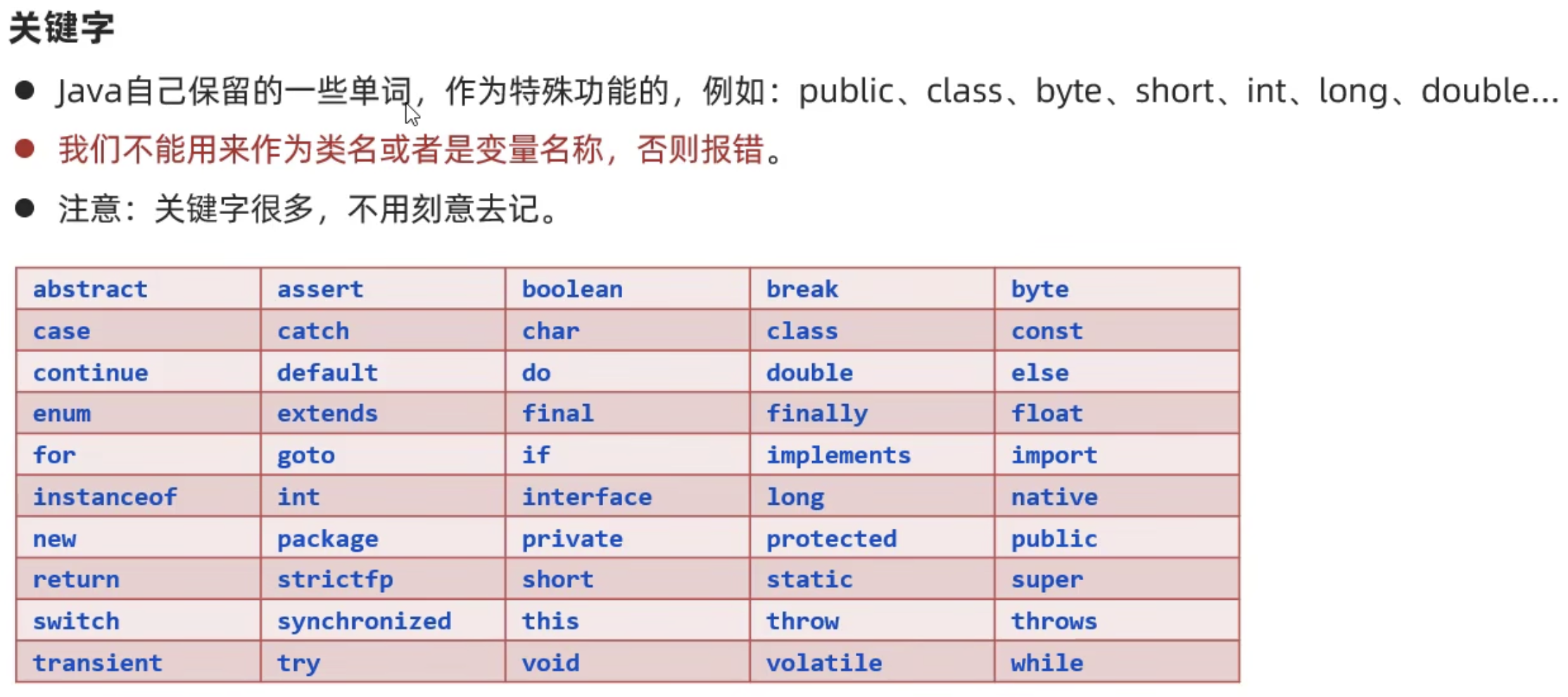
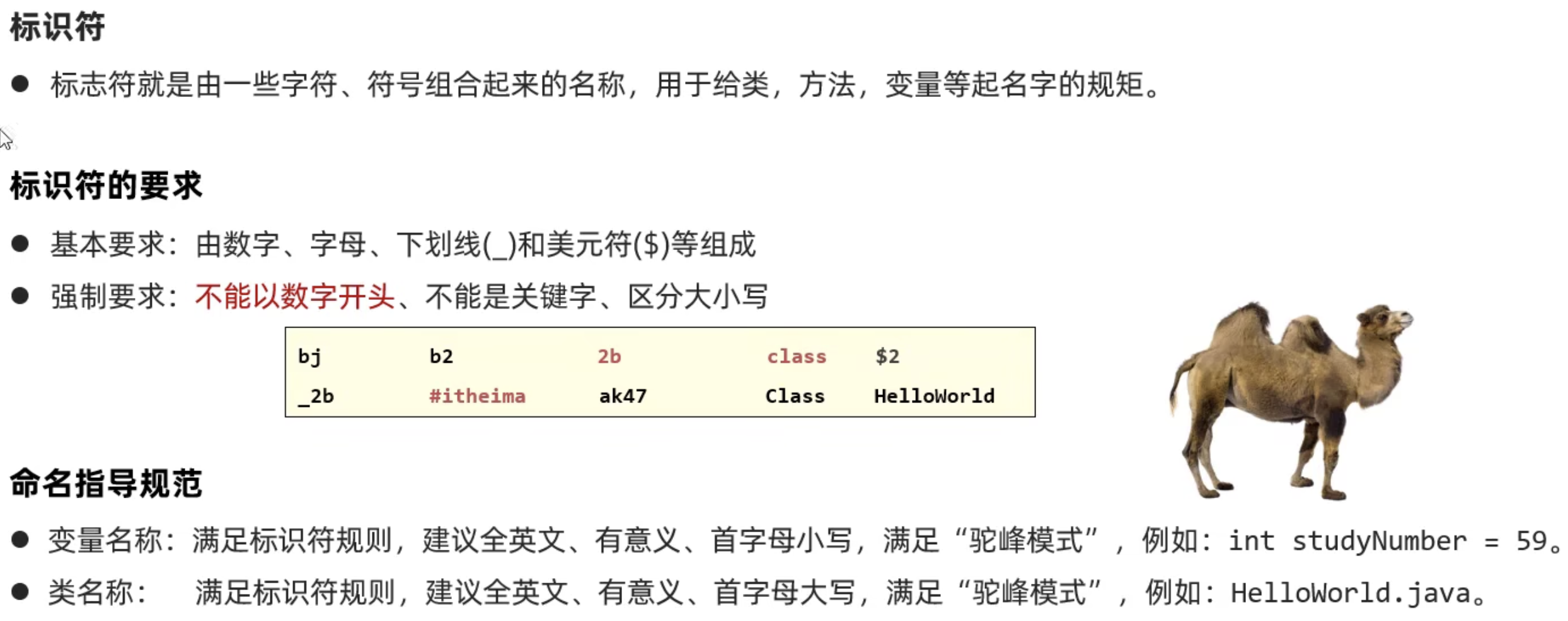
3. JavaSE基础语法续(类型转换、运算符、调用Java提供的程序)
类型转换知识、运算符的使用、怎么调用Java提供的程序
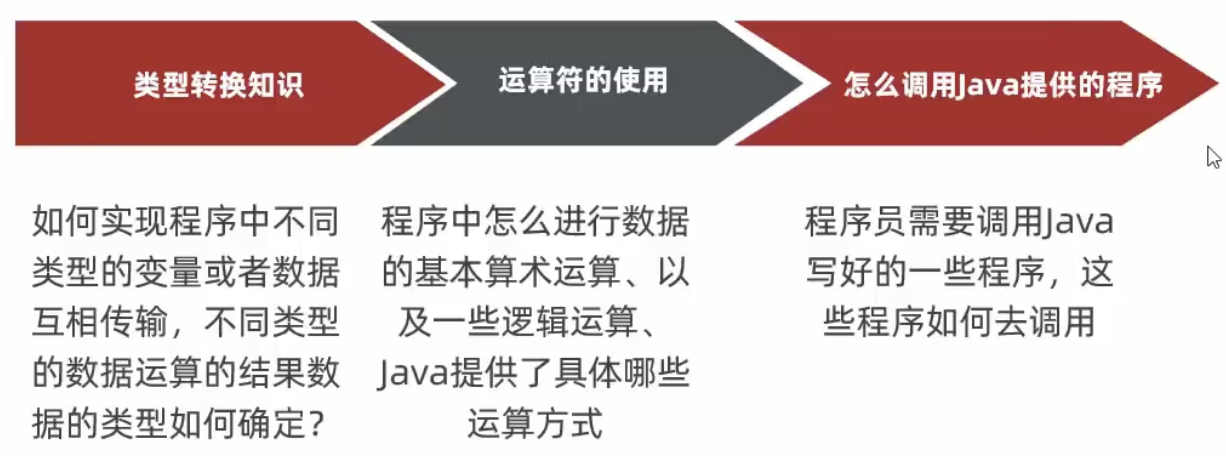
3.1 类型转换
3.1.1 自动类型转换
1
2
3
| byte a = 12;
int b = a;
System.out.println(b);
|

3.1.2 表达式的自动类型转换
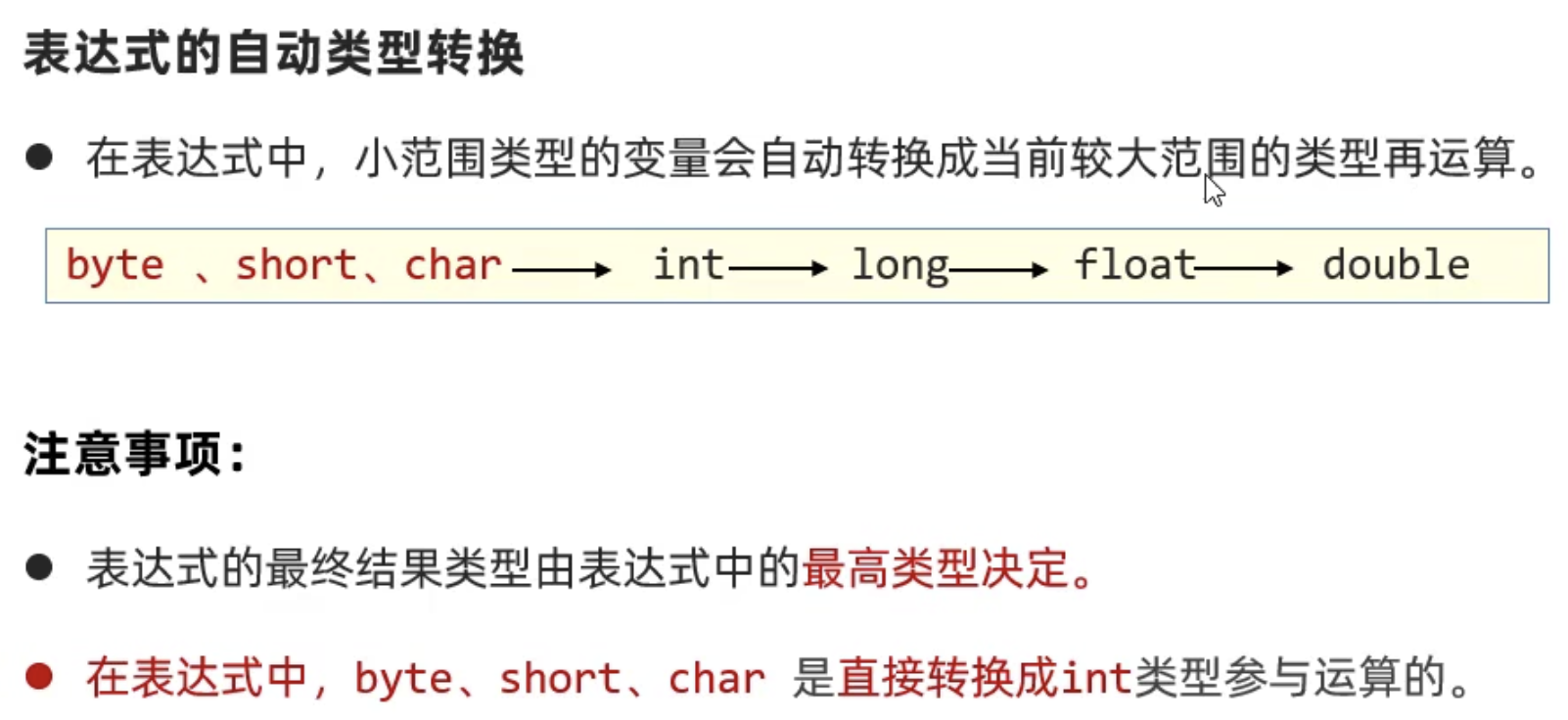
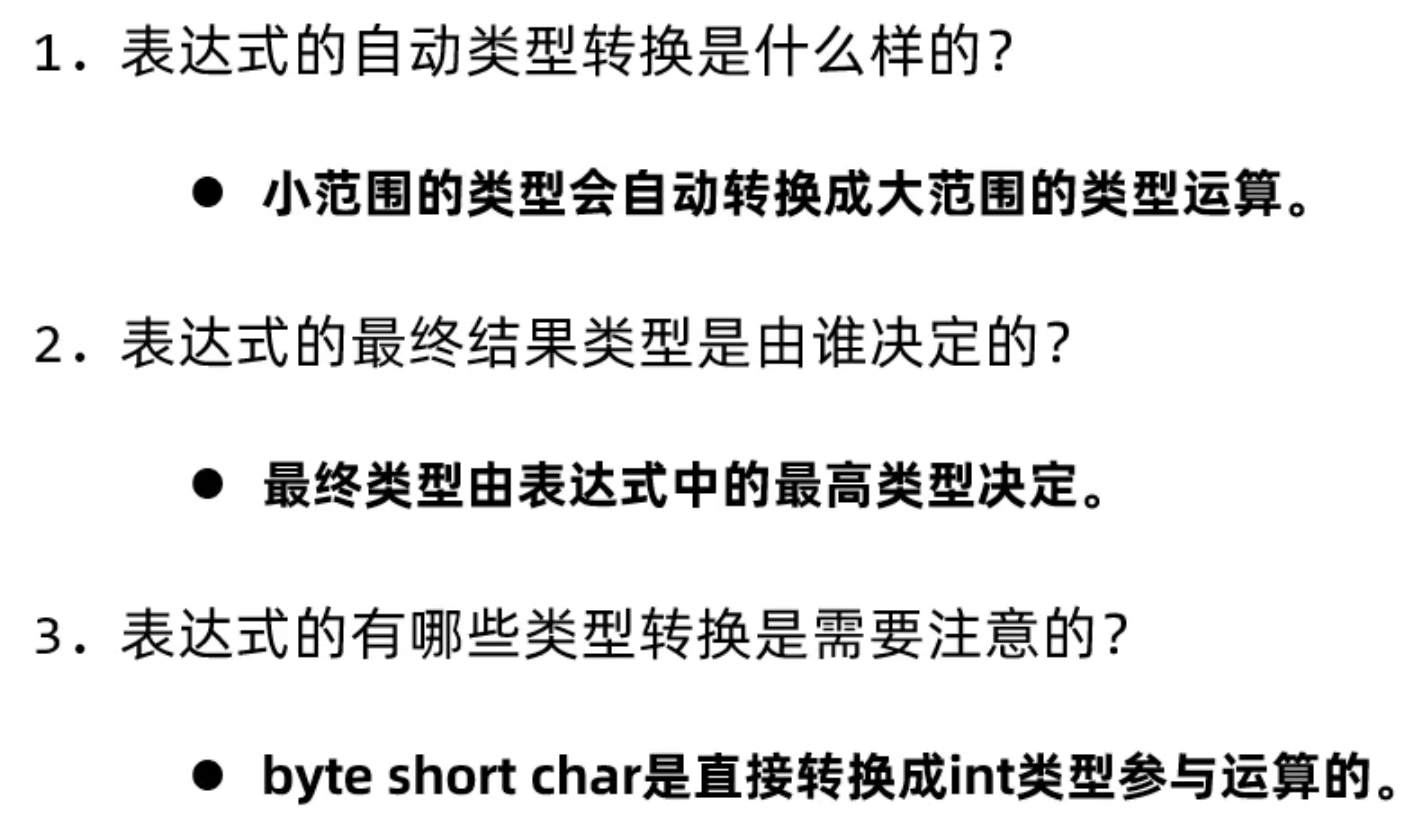
3.1.3 强制类型转换

1
2
3
| int a = 20;
byte b = (byte) a;
System.out.println("b: " + b);
|



3.2 运算符
注意6 * 1.0 / 7这种问题
+做连接符,能算就算,不能算就加在一起!
自增自减++ --,这里注意5++和++5,5++是先赋值再加吧应该。面试如果考自增自减这块,那是纯纯的nt
赋值运算符:= += -= ...
关系运算符:== != > >= < <=
逻辑运算符:& | ^ !,条件运算符中的&& ||注意熔断操作(对应python的and和or)
三元运算符:条件表达式?值1:值2,自己测试score > 60 ? true:false
1
2
3
4
| boolean flag;
int score = 61;
flag = score > 60? true:false;
System.out.println(flag);
|
3.3 键盘录入的一个case
1
2
3
4
5
6
7
8
9
|
import java.util.Scanner;
...
Scanner sc = new Scanner(System.in);
int test = sc.nextInt();
System.out.println(test);
|
导入包的过程是自动的
这里在ACM模式还要学习其他人的输入方法,如果真的ACM还可以使用一些快读的方法
3.4 程序流程控制
if switch for while do-while break continue
switch不能用浮点数,浮点数有精度不准确问题

4. 数组基础int[] arr = {1,2,3}
4.1 数组的定义
4.1.1 静态初始化数组
1
2
| int[] arr = {1,2,3,4,5};
String[] names = {"Alice", "Bob", "Charle"};
|
数组的访问,注意这里数组的长度names.length
1
2
3
4
5
| Random random = new Random();
for (int i = 0; i < names.length; i++) {
int index = random.nextInt(3);
System.out.println("index: " + index + "\tnames: " + names[index]);
}
|
4.1.2 动态初始化数组
1
2
| int[] arr = new int[5];
String[] names = new String[5];
|
补充:一种简单的编译方法(类似for item in tmp:)
1
2
3
4
| int[] test = {1,2,3,4,5};
for (int item: test) {
System.out.println(item);
}
|
4.1.3 动态初始化数组的元素默认值

4.1.4 初始化数组全为一个值
1
2
| int[] arr = new int[20];
Arrays.fill(arr, 5);
|
4.1.5 二维数组的定义和初始化
1
2
3
4
5
6
7
8
9
| int[][] matrix = new int[10][10];
for (int[] row: matrix) {
Arrays.fill(row, 7);
}
for (int i = 0; i < matrix.length; i++) {
for (int j = 0; j < matrix[0].length; j++) {
System.out.println(matrix[i][j]);
}
}
|
5. 方法基础
方法是一种语法结构,可以把一段代码封装成一个功能,以方便重复调用
5.1 方法的定义
1
2
3
| public static int twoSum(int a, int b) {
return a + b;
}
|
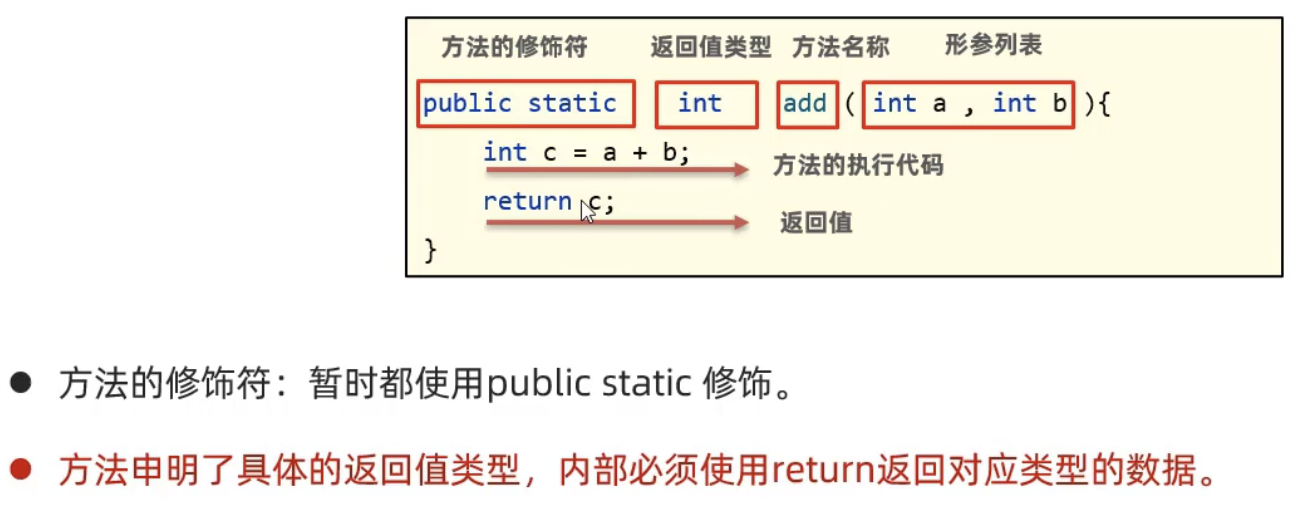
1
2
3
| public static void twoSum() {
sout"Hello, World";
}
|
补充:静态方法的调用,调用另外一个类的静态方法
假设同目录下,有Test.java和Student.java两个类
在Student.java中,如果声明静态方法(public static这里的static),则可以不实例化对象直接调用
1
2
3
4
5
6
7
| public class Student {
public static void show(int[][] matrix) {
for (int[] row: matrix) {
System.out.println(Arrays.toString(row));
}
}
}
|
如果是非静态方法,则必须实例化后才能调用
1
2
3
4
5
6
7
| public class Student {
public void show(int[][] matrix) {
for (int[] row: matrix) {
System.out.println(Arrays.toString(row));
}
}
}
|
1
2
| Student stu = new Student();
stu.show(matrix);
|
这个不仅是跨文件,在一个文件内也要遵从这种方法
在python中,是需要额外加@staticmethod做修饰的,但一般是用不上的
5.2 方法参数传递机制
5.2.1 基本类型的参数传递(以基本类型为例,传递值)
如果是这种简单基本类型的,在里面不会有改动
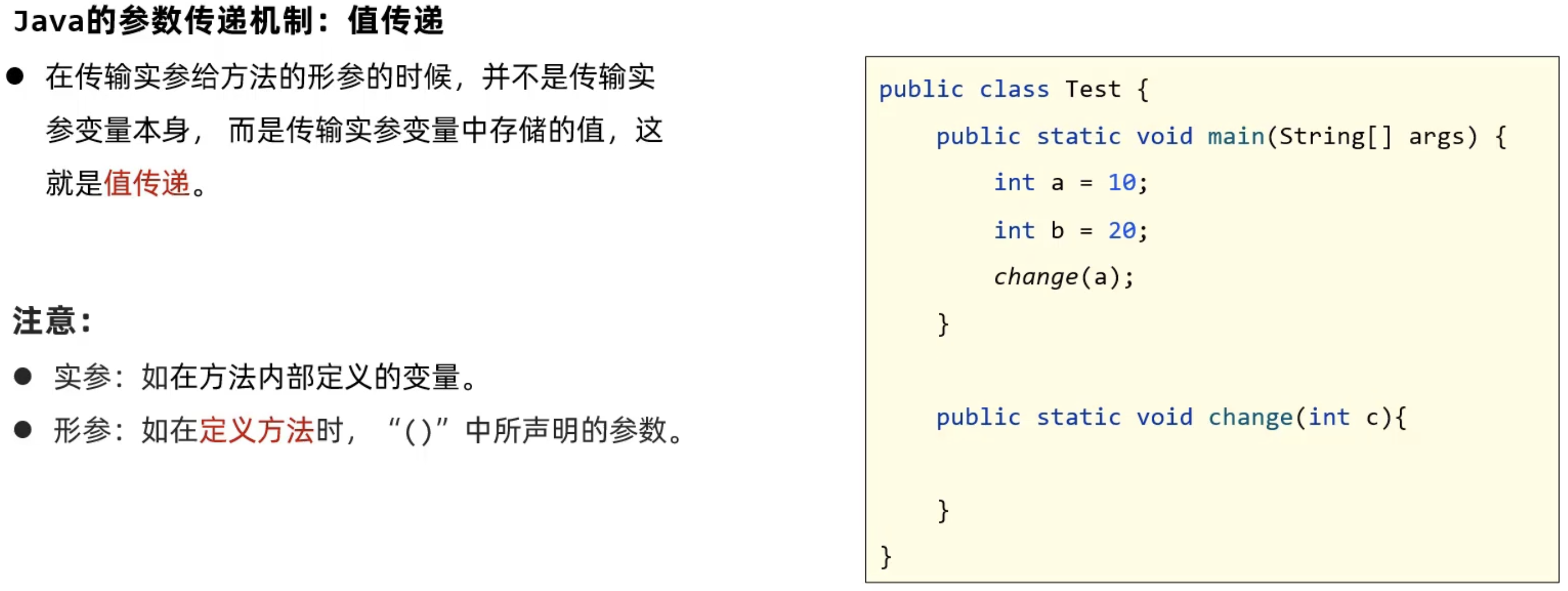
5.2.2 引用类型的参数传递(以数组为例,传递地址)
如果是引用类型的,在里面就会被修改了,因为传递的是地址

5.3 方法重载
同一个类中,出现多个方法名称相同,但是形参列表是不同的,那么这些方法就是重载方法
会根据传入的形参类型,去选择相应的方法
1
2
3
4
5
6
7
8
9
10
11
12
13
| double aa = 0.5;
double bb = 0.3;
double doubleres = twoSum(aa, bb);
System.out.println(doubleres);
public static int twoSum(int a, int b) {
return a + b;
}
public static double twoSum(double a, double b) {
return a + b;
}
|
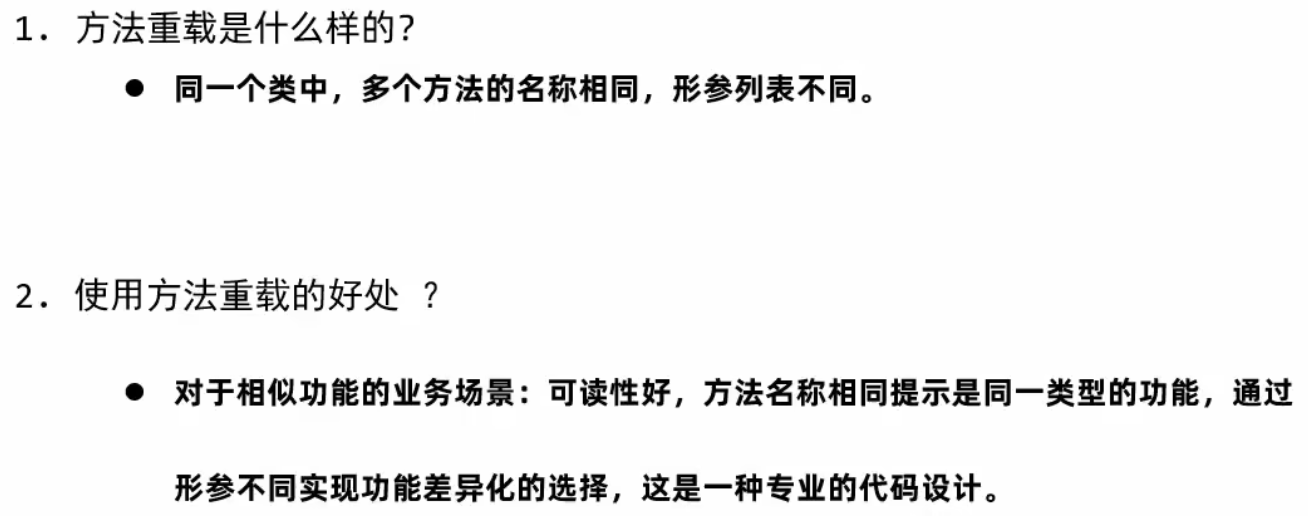

6. 面向对象
学习自己设计对象并使用
6.1 设计对象并使用
6.1.1 设计类,创建对象并使用
类:是对象共同特征的描述
对象:类的实例化

Car类
1
2
3
4
5
6
7
8
9
10
11
12
| package com.curious.javase.createobject;
public class Car {
String name;
double price;
public void start() {
System.out.println("汽车启动了");
}
}
|
使用:
1
2
3
4
5
6
7
8
9
10
11
12
| package com.curious.javase.createobject;
public class ObjectTest01 {
public static void main(String[] args) {
Car c = new Car();
c.start();
c.name = "宝马";
System.out.println(c.name);
}
}
|
这个是弄完了能直接使用的,而没有加什么getter setter方法,那些好像还挺关键的,不知道在哪里会提到
实际开发中,建议一个代码文件只定义一个类,比较规范
补充:垃圾回收
注意:当堆内存中的对象,没有被任何变量引用(指向)时,就会被判定为内存中的”垃圾“
如Student s1 = new Student();,然后s1 = null;
Java存在自动垃圾回收器,会定期进行清理
6.2 构造器+this关键字(有参数构造器、无参数构造器)
6.2.1 构造器
承上启下的内容,这里就有点和之前的知识不懂了
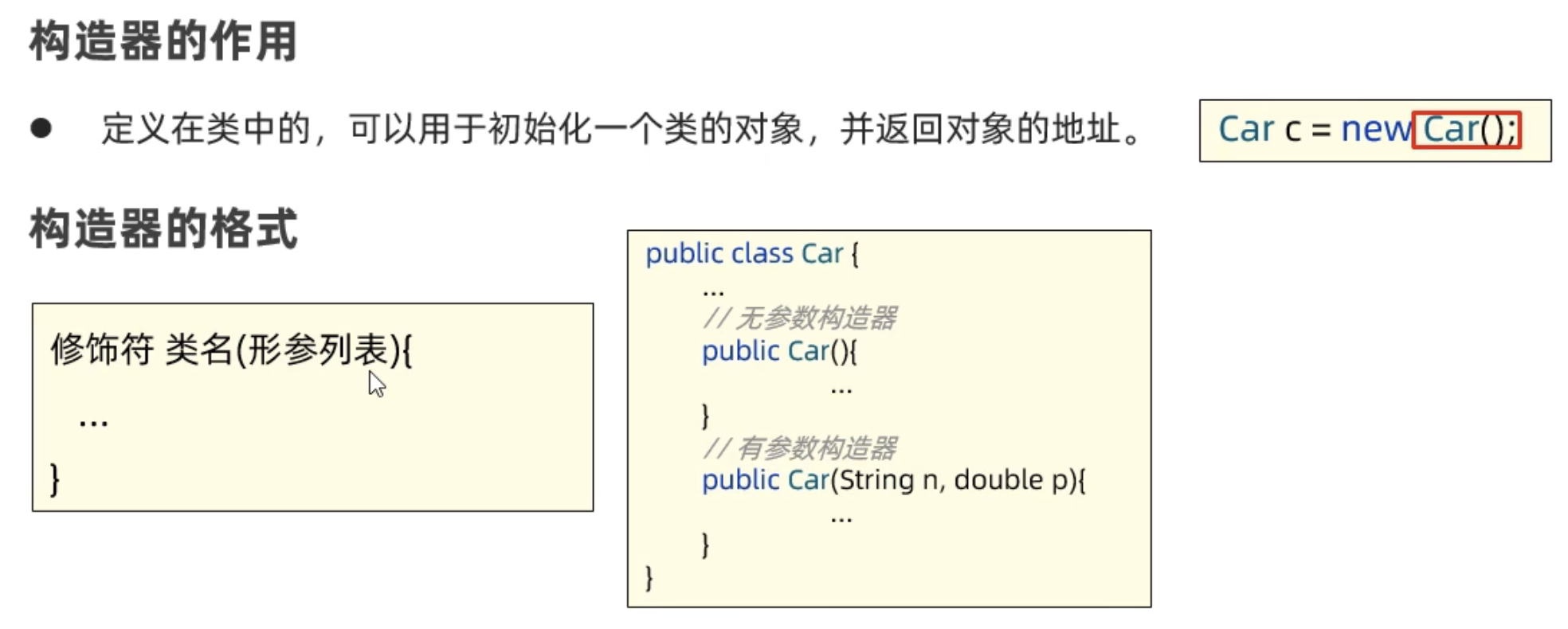
有点类似python的def __init__()

一旦定义了有参数构造器,那么无参数构造器就没有了,如果还想用无参数构造器,此时就需要手写一个无参数构造器了
1
2
3
4
5
6
7
8
9
10
11
12
13
14
15
16
17
18
19
| package com.curious.javase.createobject;
public class Car {
String name;
double price;
public Car() {
System.out.println("调用了无参数的构造器");
}
public Car(String name, double price) {
this.name = name;
this.price = price;
}
public void start() {
System.out.println("汽车启动了");
}
}
|
6.2.2 this关键字
可以出现在构造器,这个和python的self好像是不是很像的感觉,就是用上面那种构造器做一个初始化的感觉?
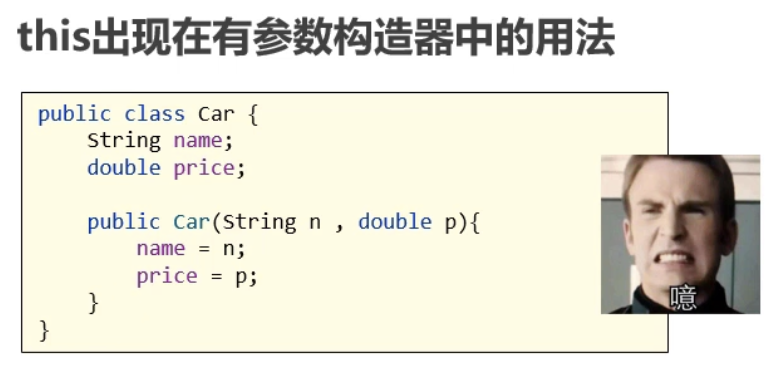
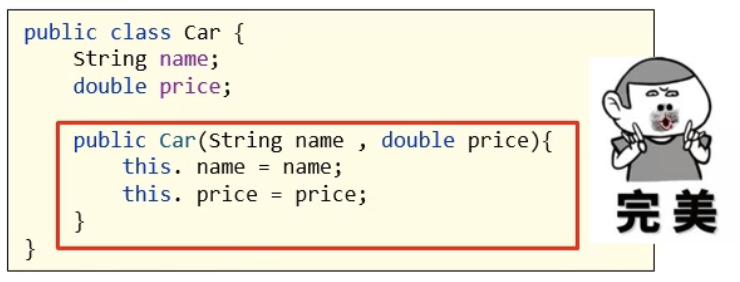
一个文件中,出现多个class,只能有一个是public的?还需要从代码刷题的角度来理解这个事情
6.3 封装(getter setter方法)
6.3.1 封装的概述
面向对象的三大特征:封装、继承、多态
封装:告诉我们,如何正确设计对象的属性和方法
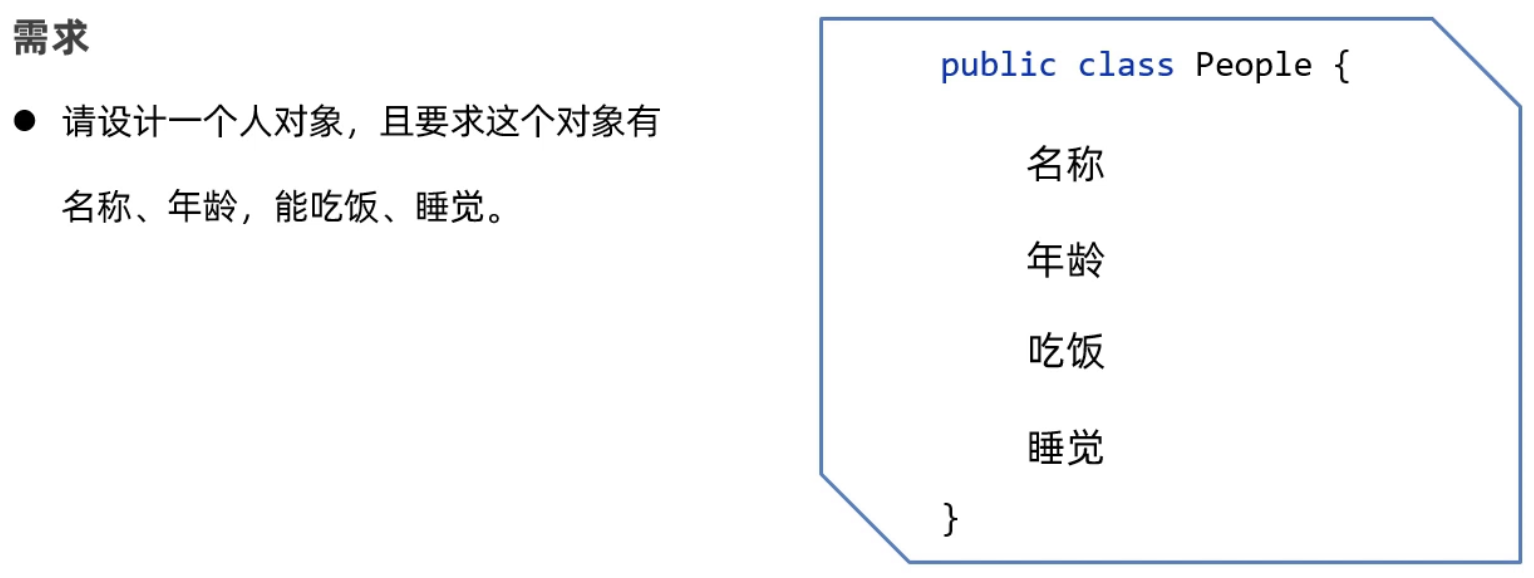

封装的原则:对象代表什么,就得封装对应的数据,并提供数据对应的行为
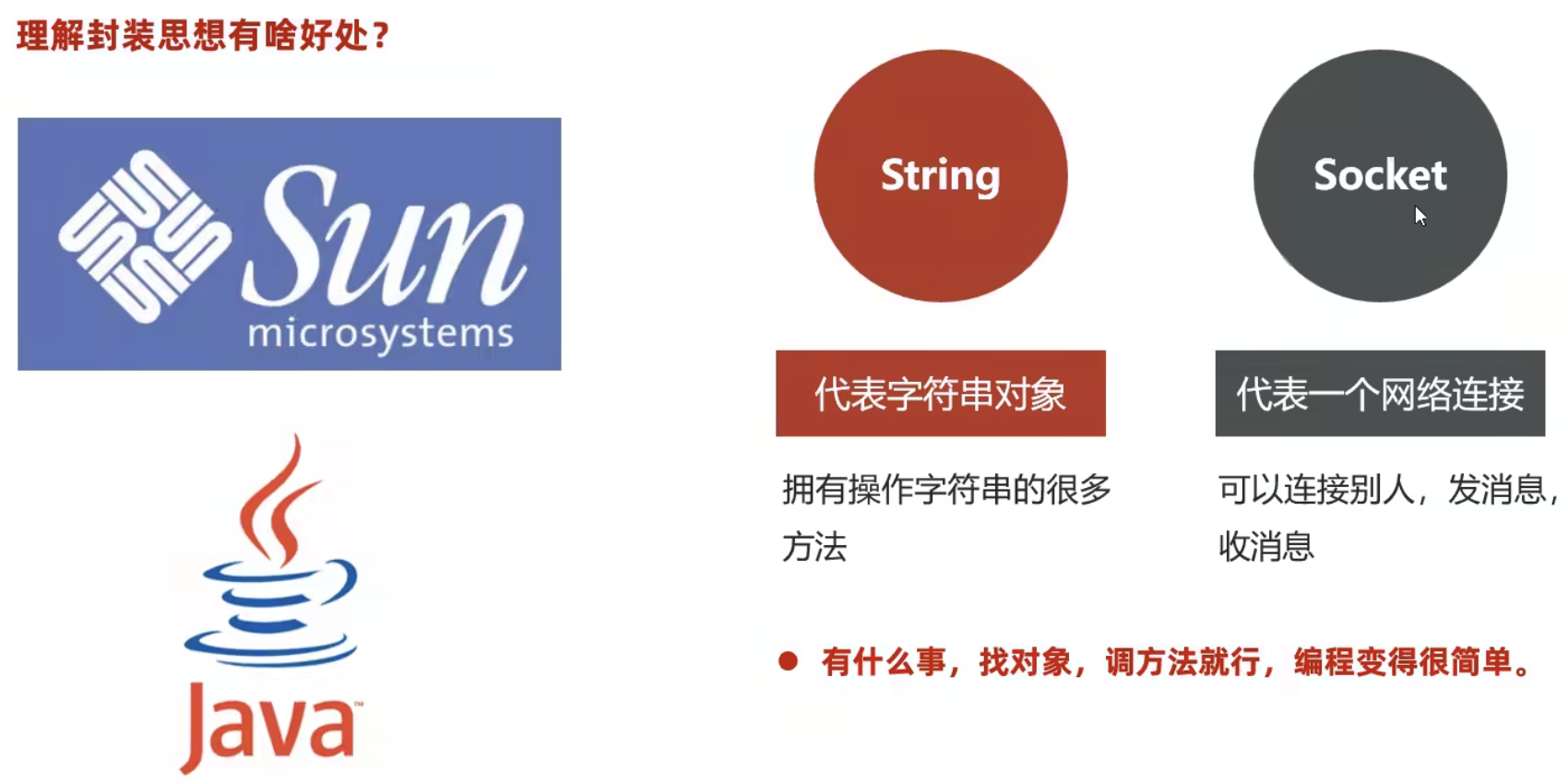
6.3.2 如何进行更好的封装?
一般建议对成员变量使用private关键字进行修饰(private修饰的成员只能在当前类中访问)
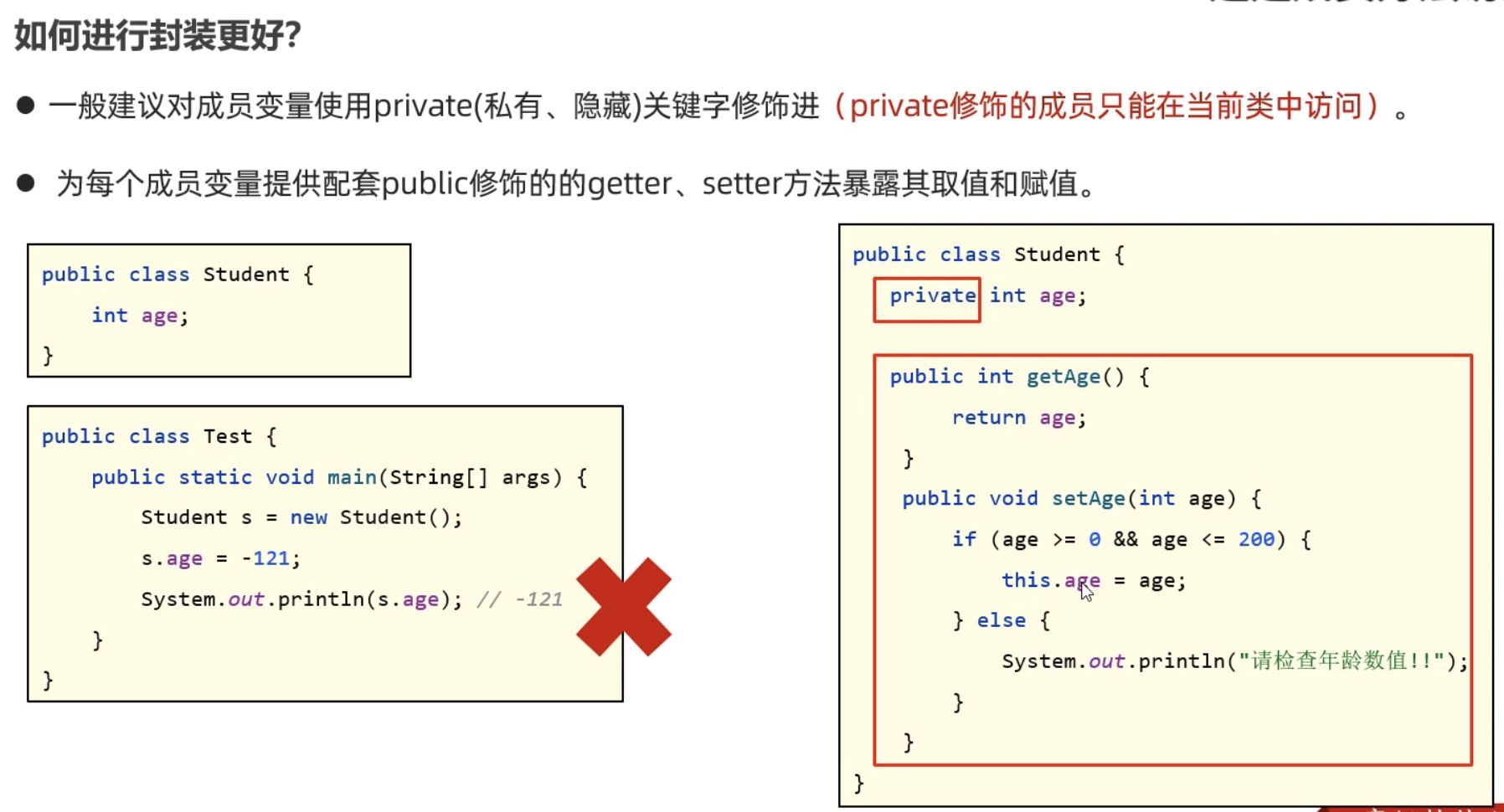
1
2
3
4
5
6
7
8
9
10
11
12
13
| package com.curious.javase.createobject;
public class Student {
private int age;
public int getAge() {
return this.age;
}
public void setAge(int age) {
this.age = age;
}
}
|
6.4 标准JavaBean(一种对象的很标准的写法)
也可以称为实体类,其对象可以用于在程序中封装数据
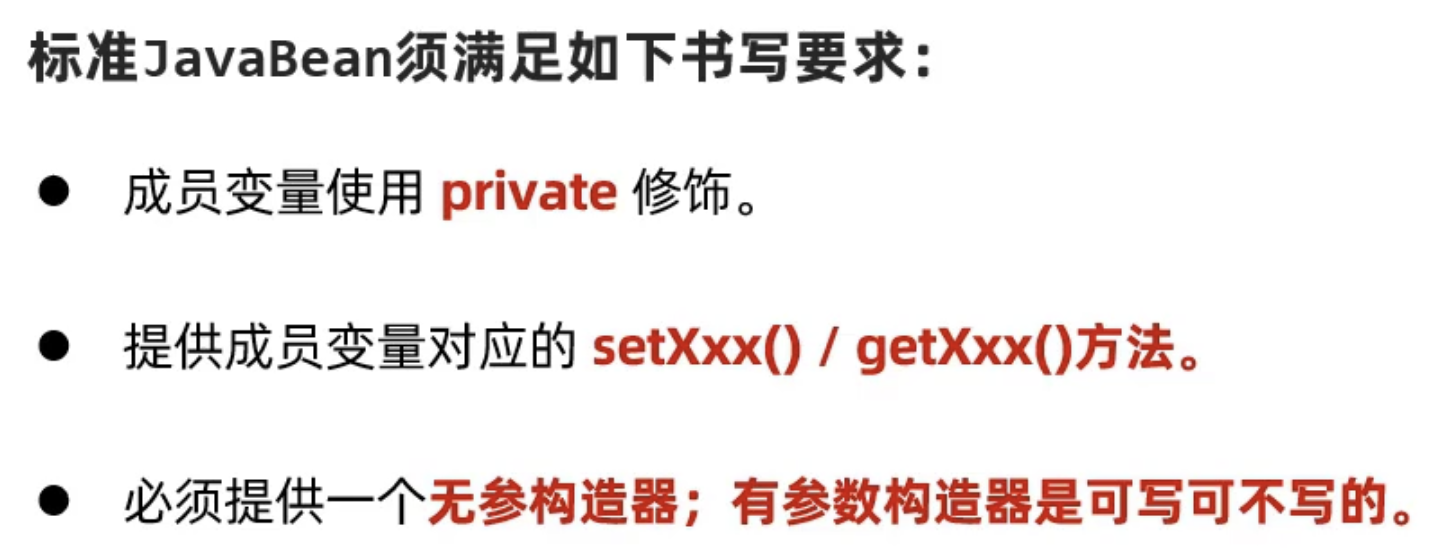
可以自动生成,在IDEA写完成员变量后,可以自动generate的getter setter方法
7. 常用API——String、ArrayList
7.1 String

7.1.1 String类概述
1
| String name = "Curious";
|
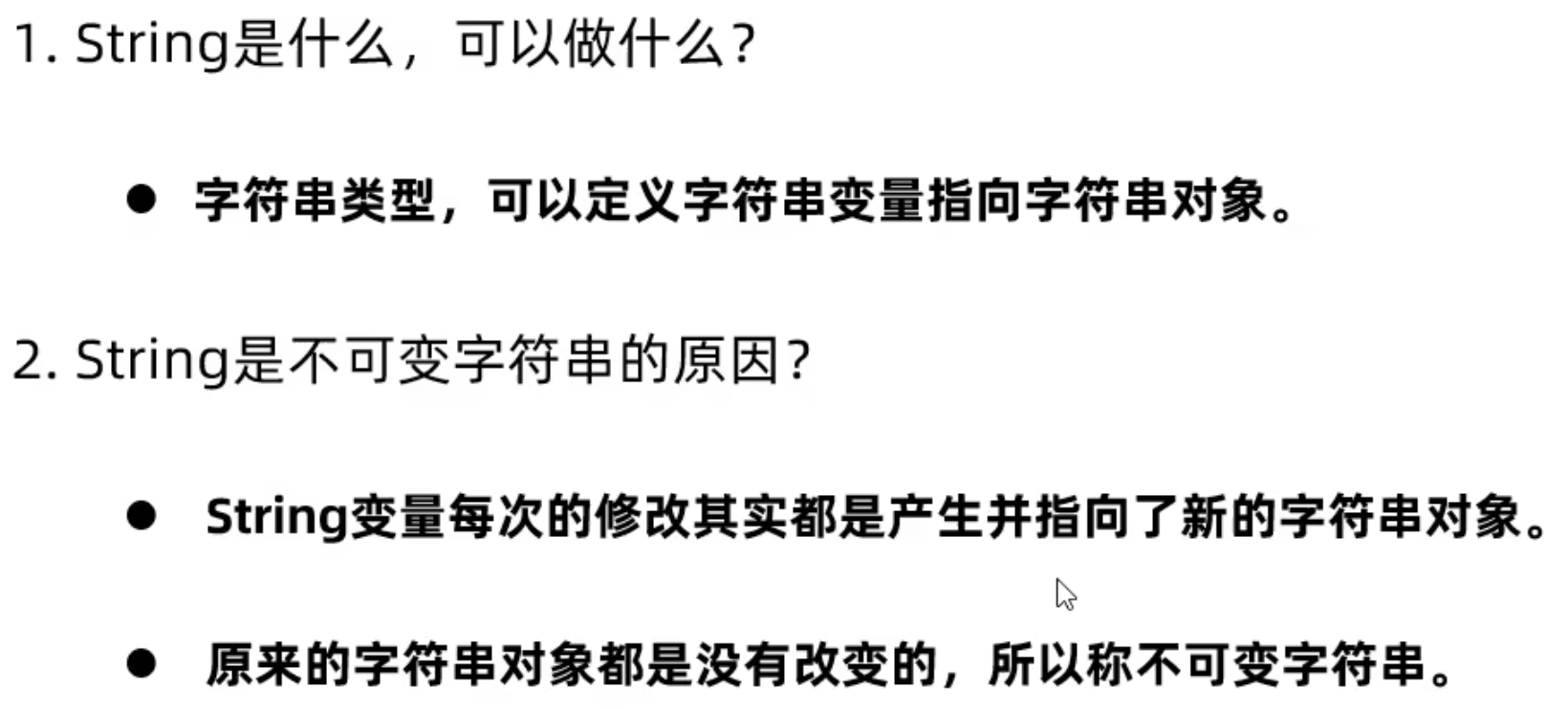
7.1.2 String类创建字符串对象的2种方式
1
2
3
4
5
6
|
String name = "123";
String s1 = new String("123");
String s1 = new String(char[] c);
|
补充:字符串的比较
1
2
3
| String ss1 = "abc";
String ss2 = "abc";
ss1 == ss2;
|
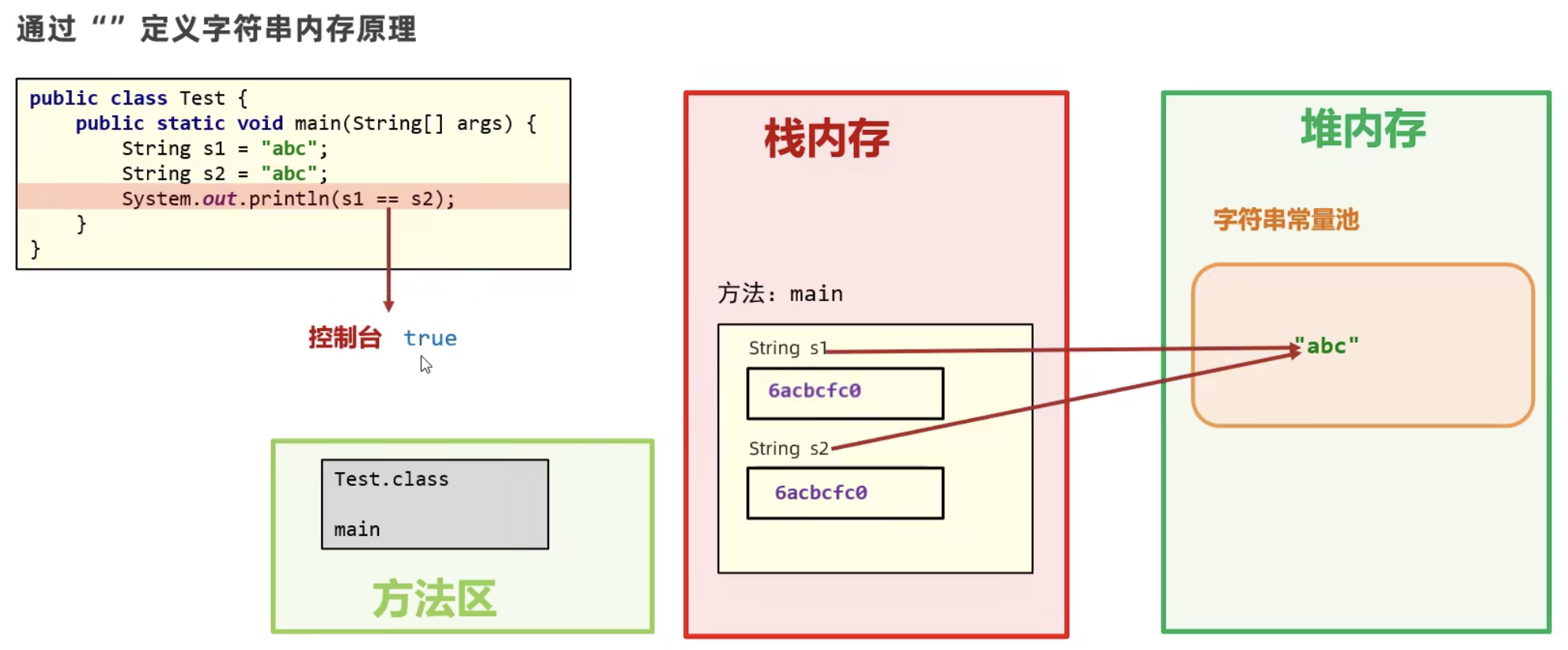
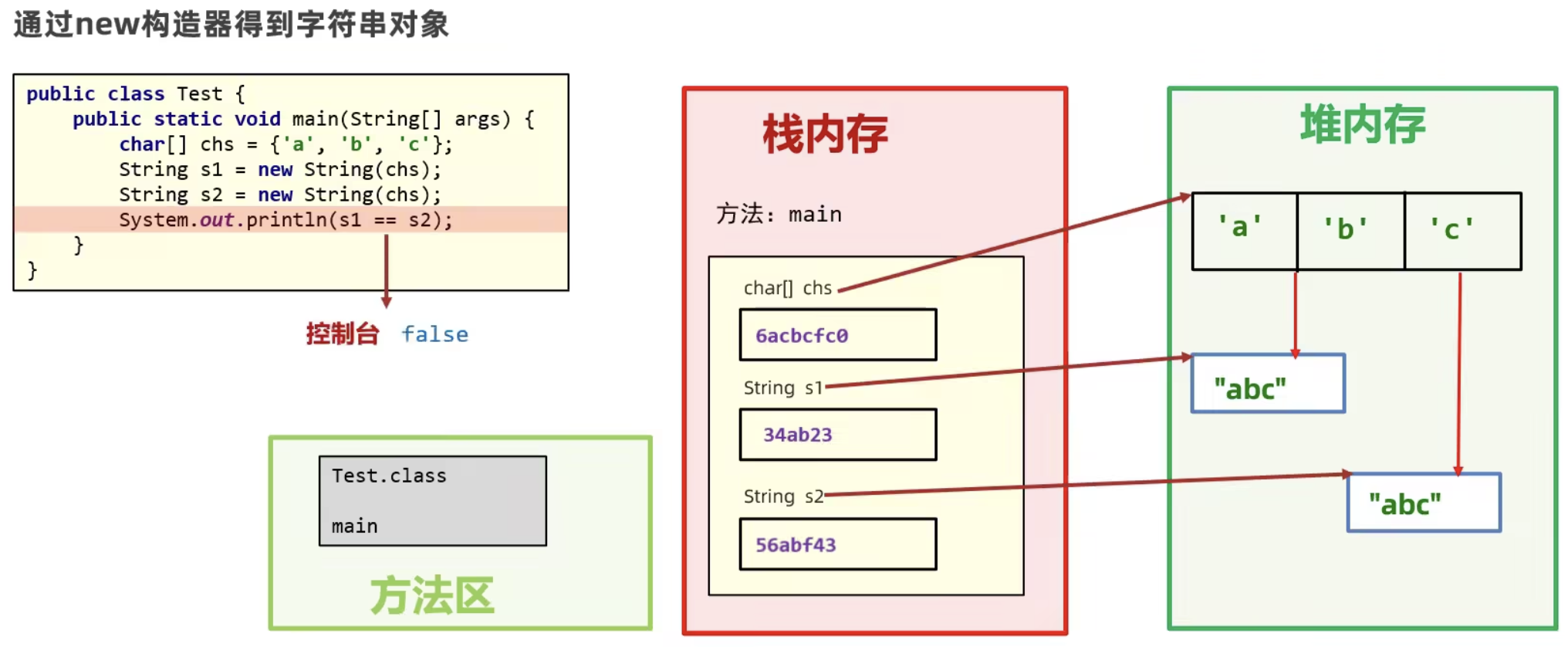
Q:使用java比较两个字符串是否相等
A:
在 Java 中,可以使用 String.equals() 方法来比较两个字符串是否相等。
例如:
1
2
3
4
5
6
7
8
| String str1 = "Hello";
String str2 = "Hello";
if (str1.equals(str2)) {
System.out.println("The strings are equal.");
} else {
System.out.println("The strings are not equal.");
}
|
在这个例子中,输出会是 “The strings are equal.”。
注意:在比较字符串时,不能使用 == 运算符。这是因为 == 运算符比较的是两个对象的引用(即内存地址)是否相同,而不是实际的字符串内容是否相同。因此,如果使用 == 运算符来比较两个字符串,只有在两个字符串引用同一个对象时才会返回 true,否则会返回 false。
例如:
1
2
3
4
5
6
7
8
| String str1 = "Hello";
String str2 = "Hello";
if (str1 == str2) {
System.out.println("The strings are equal.");
} else {
System.out.println("The strings are not equal.");
}
|
在这个例子中,输出会是 “The strings are equal.”,因为 str1 和 str2 引用了同一个字符串对象。但是,如果将这个例子改为这样:
1
2
3
4
5
6
7
8
| String str1 = "Hello";
String str2 = new String("Hello");
if (str1 == str2) {
System.out.println("The strings are equal.");
} else {
System.out.println("The strings are not equal.");
}
|
这个例子中,输出会是 “The strings are not equal.”,因为 str2 是使用 new 关键字创建的新的字符串对象,它的引用
7.1.3 字符串内容比较API str1.equals(str2)
1
2
3
4
5
| String stra = "hello";
String strb = "hello";
String strc = "HelLO";
System.out.println(stra.equals(strb));
System.out.println(stra.equalsIgnoreCase(strc));
|
7.1.4 常用API——遍历、替换、截取、分割
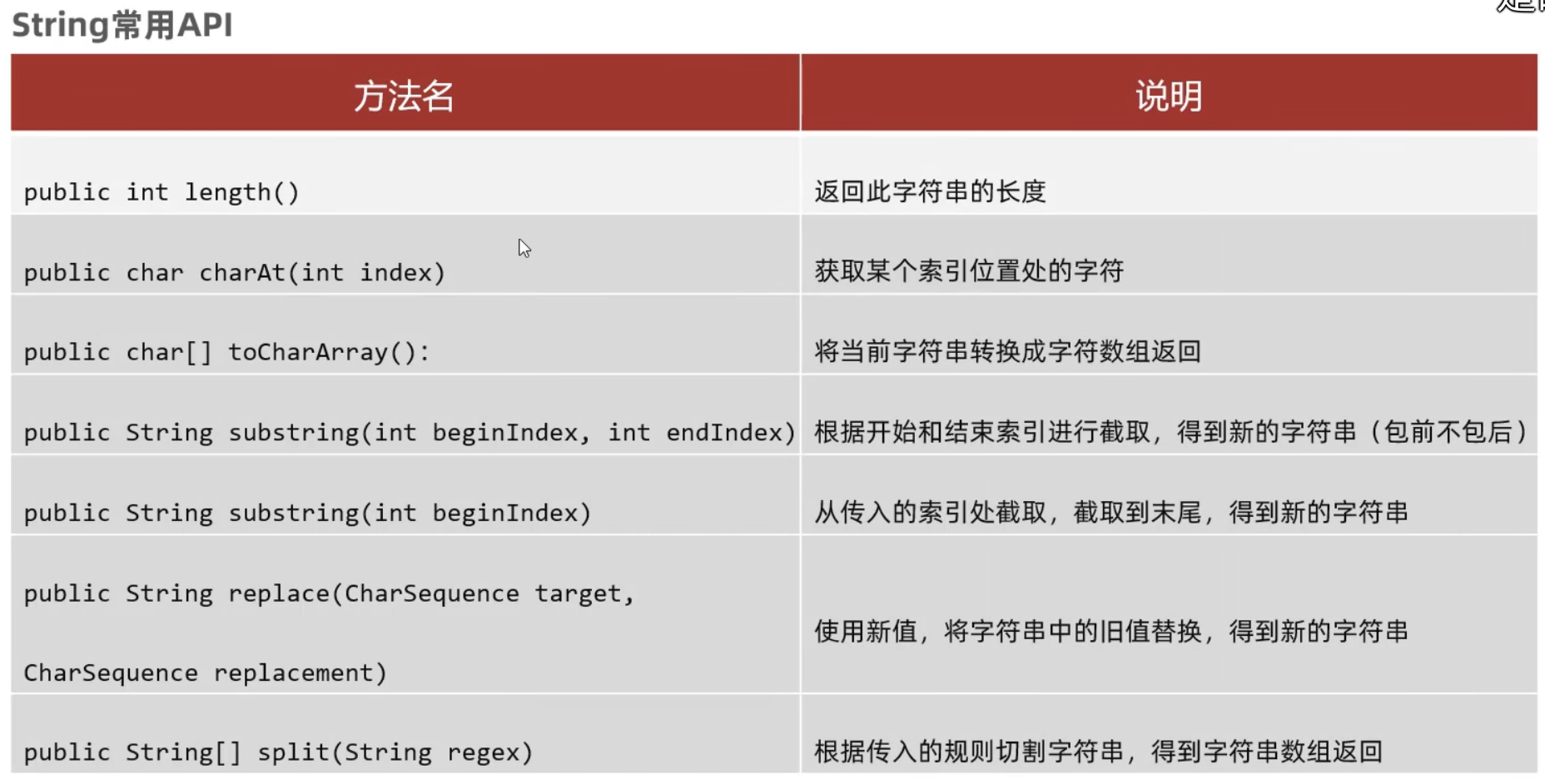
还有contains,startsWith这些的方法等等
7.2 ArrayList
集合类,集合的大小是不固定的,类似python的list?随时进行add操作这样的感觉

数组的长度是确定的,类型是hi固定的,但是在个数不能确定的情况下,用数组就不是很合适了
实际上有了ArrayList后,用数组的场景就会比较少了?
类型可以不固定,是个很关键的
ArrayList是集合中的一种,支持索引
7.2.1 ArrayList集合添加元素的方法

1
2
3
4
5
6
7
8
9
10
11
12
| ArrayList tmp = new ArrayList();
tmp.add("Hello");
tmp.add(123);
tmp.add(1, 5.6)
for (int i = 0; i < tmp.size(); i++) {
System.out.println(tmp.get(i));
}
|
多种类型都可以添加的
这个添加是有返回值的,一般不会失败
7.2.2 ArrayList对于泛型的支持
泛型的概念在这里第一次听说,之前也听说过不过这里算是一个正式的接触
motivation:实际开发中,java不希望我们存类型不确定的元素,可能要给封装到一起那种的
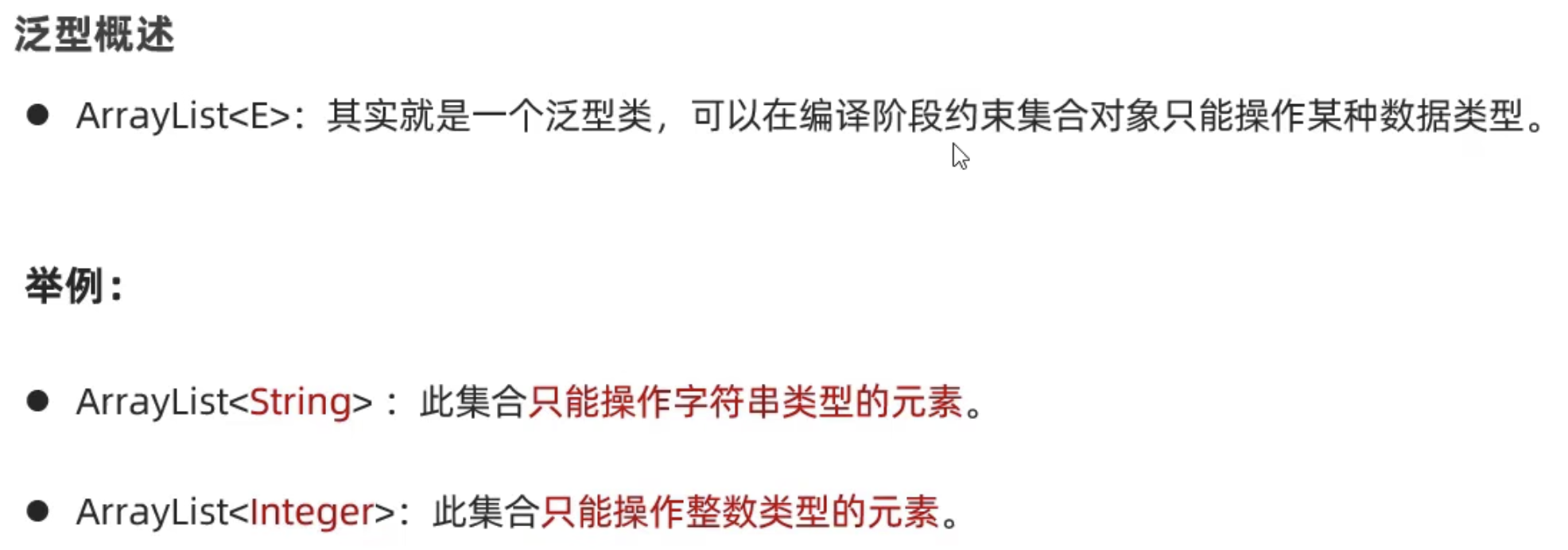
注意:集合中只能存储引用类型,不支持基本数据类型
1
2
3
4
5
6
7
| ArrayList<Integer> int_list = new ArrayList<>();
int_list.add(1);
int_list.add(2);
int_list.add(3);
for (int i = 0; i < int_list.size(); i++) {
System.out.println(int_list.get(i));
}
|
7.2.3 ArrayList常用API,遍历
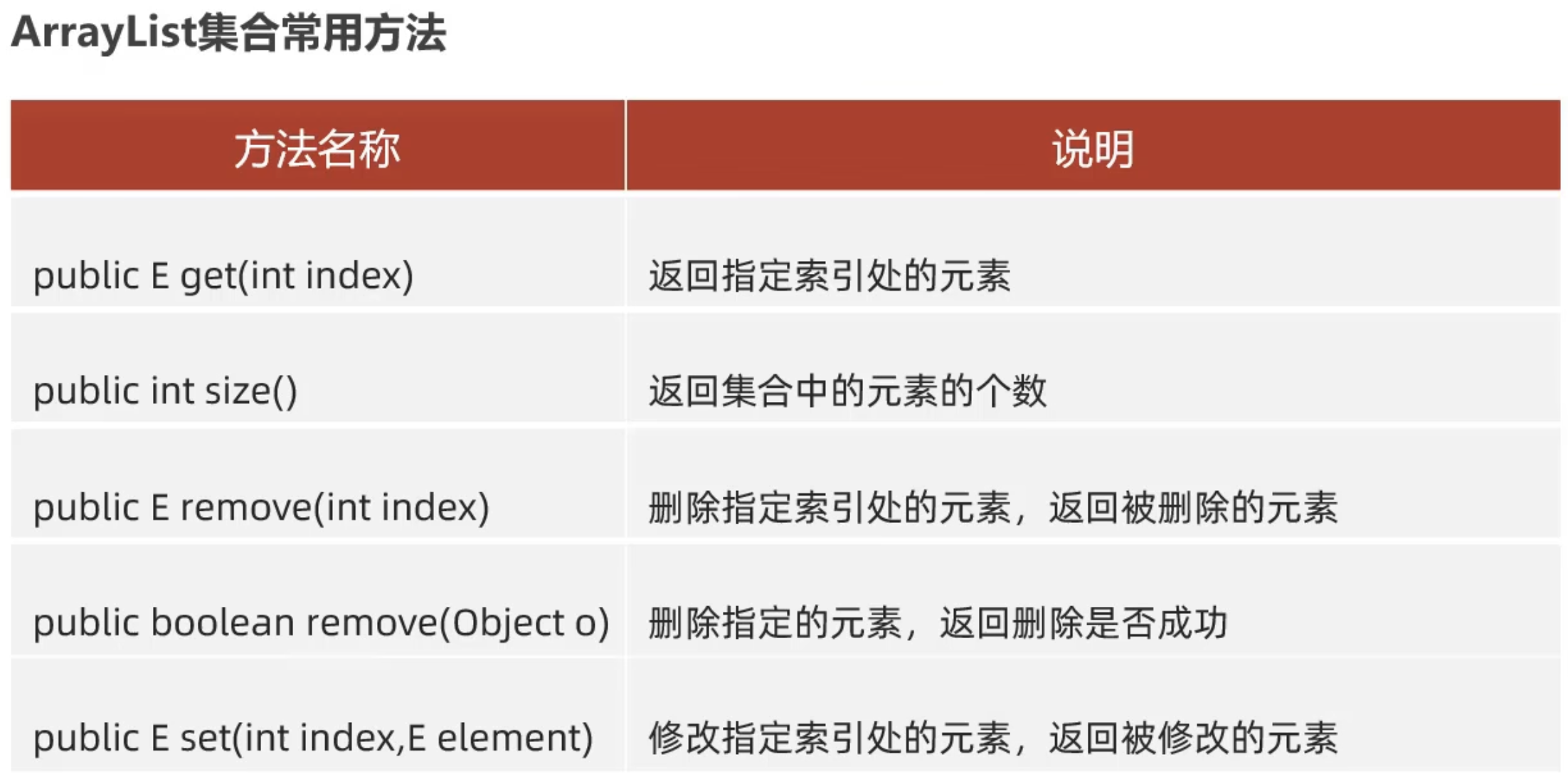
1
2
3
4
5
6
7
8
9
10
11
12
13
14
15
16
| ArrayList<String> stringList = new ArrayList<>();
stringList.add("abc");
stringList.add("abc");
stringList.add("abc");
stringList.add("def");
stringList.remove("abc");
String resString = stringList.remove(stringList.size()-1);
for (int i = 0; i < stringList.size(); i++) {
System.out.println(stringList.get(i));
}
System.out.println(resString);
abc
abc
def
|
remove只能删除一次
7.2.4 ArrayList遍历并删除元素值

坑点在于:删除的时候,角标会有变化?
1
2
3
4
5
6
7
8
9
10
11
12
13
14
15
16
17
18
19
| ArrayList<Integer> scores = new ArrayList<>();
scores.add(98);
scores.add(77);
scores.add(66);
scores.add(89);
scores.add(79);
int i = 0;
while (i < scores.size()) {
if (scores.get(i) < 80) {
scores.remove(i);
} else {
i ++;
}
}
for (int j = 0; j < scores.size(); j++) {
System.out.println(scores.get(j));
}
|
7.2.5 ArrayList存储自定义类型的对象
1
2
3
4
5
6
7
8
9
10
11
12
13
14
15
16
17
18
19
20
21
22
23
24
25
26
27
28
29
30
31
32
33
34
35
36
| package com.curious.javase.arraylist;
public class Student {
private int age;
private String name;
public Student() {
}
public Student(int age, String name) {
this.age = age;
this.name = name;
}
public int getAge() {
return age;
}
public void setAge(int age) {
this.age = age;
}
public String getName() {
return name;
}
public void setName(String name) {
this.name = name;
}
public void show() {
System.out.println("[" + this.age + ", " + this.name + "]");
}
}
|
1
2
3
4
5
6
7
8
9
10
11
| ArrayList<Student> students = new ArrayList<>();
Student s1 = new Student(10, "AAA");
Student s2 = new Student(11, "BBB");
Student s3 = new Student(12, "CCC");
students.add(s1);
students.add(s2);
students.add(s3);
for (int i = 0; i < students.size(); i++) {
students.get(i).show();
}
|






















































